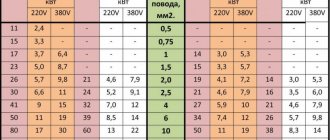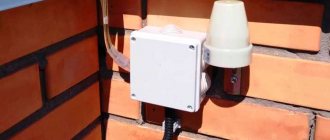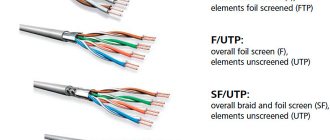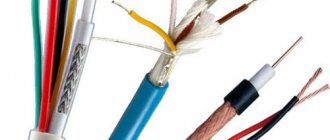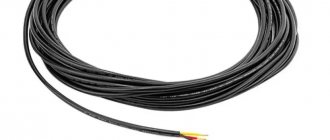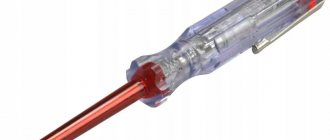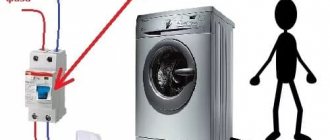Purpose of RCD and principle of operation
It is important to understand that this device protects against excess current, and not against voltage surges and short circuits. At the same time, a circuit breaker protects the electrics in the house, and a residual current device can reduce the risk of electric shock.
The RCD is not designed to protect against short circuits, so it is imperative to connect a circuit breaker to it. Before deciding which RCD to choose, you need to know its design and operating principle.
There are several coils located inside the housing. One coil is connected to the phase, the other to the neutral wire. Current passing through the coils creates magnetic fields. Since they are directed in opposite directions, they destroy each other. If the current passing through one of the coils is stronger than it should be, then an excess field is formed, which directs it to the third coil. When the third coil starts working, the RCD protection is activated as intended and turns off the electricity in this area of the house.
Based on the principle of operation of the device, the question of how to choose the right RCD for a house or apartment is resolved.
How to install the device - example with a boiler
Technically, it is very easy to install an RCD - strip the contacts of insulation and secure them with clamping screws.
Let's look at an example of connecting a breaker to a Termex boiler:
- We test the wiring contacts and find the line and neutral.
- We insert the neutral into the RCD socket marked with the letter “N”.
- We insert the line into the free socket on the same side. At the same time, in order for the breaker to start working, the connection to the network can be made both from the top and from the bottom of the unit body.
- We connect the free contacts in the RCD body with the corresponding connectors of the boiler.
Ready! Now the electrical appliance will work under protection. Just don’t forget to test the RCD at least once a month. To do this, just press the “Test” button on the case. And if the breaker opens the circuit, then it is fully operational.
Main characteristics of the device
In order to decide which RCD is the best, when purchasing it, you must take into account all the parameters and technical characteristics.
After information about the manufacturer and brand name, data on performance characteristics and nominal values are applied to the body, such as:
- Name and series. The word “RCD” does not necessarily have to appear in the inscription; many manufacturers call it “VTD” (residual current switch).
- Rated voltage value. It must be single-phase (220 V) or three-phase (330 V) at a standard frequency of 50 Hz. If a device is selected for a private home, then you need to take one that is designed for three-phase voltage.
- Rated operating current is the maximum value that the protective device is capable of handling. There are devices for 16, 20, 25, 32, 40, 63, 80 and 100 A.
- The rated differential current is the leakage value at which the protection is triggered and the electricity is automatically turned off. This value can be 6 mA, 10 mA, 30 mA, 100 mA, 300 and 500 mA.
There is a marking on the case that tells about additional characteristics:
- The value of the rated conditional short circuit current is the maximum short circuit at which the RCD can continue to function normally, provided that an additional circuit breaker is installed with it.
- Protection response time. This is the period of time from the occurrence of a leak until it is eliminated, during which the protection is triggered. The maximum value is 0.03 s.
- Mandatory device diagram.
Classification of protective devices
Despite the simplicity of the internal structure, the choice of RCD models on the market is quite large. Each device has a certain set of technical parameters that cannot be adjusted during operation.
The manufacturer and size of the RCD do not affect the possibility of sharing within the same circuit. They can be mounted in any combination
To facilitate the selection of RCDs, options for classifying these devices should be considered.
- Based on the response speed of the mechanism, RCDs are divided into conventional and selective models. The former disconnect power contacts almost instantly, while the latter disconnect with a delay. Selective RCDs are used in multi-level systems where the sequence of operation is important.
- By type, RCD relays are divided into electromechanical, which breaks the contact mechanically, and electronic, which prevents the flow of current using a semiconductor circuit.
- By type of current . RCD type AC is disconnected from alternating current leakage, type A – from alternating and direct current.
- For additional functions : without and with network overload protection. RCDs with a short circuit or high current trigger mechanism are usually called difavtomats.
- According to the design . There are RCDs that are attached to a DIN rail, to the wall, as well as devices in the form of a socket, a portable device, or an adapter.
- By operating voltage : for 220V, 380V, combined.
- According to energy dependence . There are RCD models that are capable and unable to disconnect the power load in the absence of operating voltage.
- By the number of connected poles : two-pole and four-pole.
To choose the right RCD, it is not enough to know its technical characteristics. In order for the device to effectively perform its protective function, when purchasing it, you need to take into account the length of the home electrical wiring, the power of the connected devices and some other parameters.
How to choose the right RCD according to parameters
The choice of RCD must be carried out, paying attention to its rated and differential operating current.
Rated is the current for which the power contacts are designed. If it increases, they may fail. Differential is the operating current of the residual current device, that is, leakage.
Before choosing an RCD, it is useful to find out its price, quality and performance and compare these three parameters. Since choosing an RCD based on power and quality can be difficult for a non-professional, experts advise making a table of the parameters of the devices you like and using it to select a device with the best characteristics.
Rated current
When selecting by rated current, you need to know that the device is always placed in series with a circuit breaker to protect power contacts from overload and short circuit. If one or the other occurs, the device does not work, since it is not intended for this. Therefore, it must be protected automatically.
The next thing you should pay attention to: the rated current must at least match that declared for the machine, and it is better to be 1 step higher.
Differential current
There are two important things to remember here:
- For electrical safety purposes, a differential operating current of either 10 mA or 30 mA is always selected. For example, you can install a 10 mA RCD on one electrical receiver. At the entrance to the house, a device with this value may operate too often, since the electrical wiring in the apartment has its own leakage limits.
- All other RCDs with a differential current above 30 mA are used for fire protection purposes. But when installing a 100 mA RCD at the input, a 30 mA RCD must be installed in series with it for electrical safety purposes. In this case, it would be advisable to install a selective RCD at the input so that it operates with a short time delay and allows a device with a lower rated current to operate.
Product type
According to the form of current leakage, all these devices are classified into 3 types:
- “AC” type device. This device is common due to its more affordable price. Triggers only when a sinusoidal current leak occurs.
- Device type “A”. Designed to operate upon the instantaneous or gradual appearance of excess current, which has a variable sinusoidal and pulsating constant shape. This is the most popular type, but has an increased cost due to the ability to control both constant and variable flow.
- Type “B” device. Most often used to protect industrial premises. In addition to responding to sinusoidal and pulsating shapes, it also responds to the rectified shape of a constant leak.
In addition to these main three types, there are 2 more:
- Selective device type “S”. It does not turn off immediately, but after a specified period of time.
- Type "G". The principle is the same as the previous one, but the shutdown time is slightly shorter.
Design
By design, there are 2 types of RCDs:
- electronic - operating from an external network;
- electromechanical - independent of the network; no power is needed for its operation.
Manufacturer
An equally important criterion is the choice of manufacturer. The question of which RCD company is best to choose must be decided by the buyer himself. The following options are recommended:
Among budget models, the highest quality is from Astro-UZO and DEK.
Criterias of choice
When selecting the required RCCB model that will meet all the requirements, the following main criteria should be taken into account:
- Type of differential current. Manufactured protective devices have several varieties according to this criterion. AC – designed to fix alternating current leaks. A – designed for recording alternating direct current, which has a pulsating nature. B - can be used to protect direct or alternating electric current lines. S – provides selective protection with a time delay. G – is an analogue of type S, but has a shorter time delay.
- Number of phases Depending on the voltage of the electric line 220 V or 380 V, a two-pole or four-pole device is installed, respectively.
Advice. Electromechanical devices have higher reliability and longer service life than electronic ones. The latter are very sensitive to voltage surges and drops.
- Rated current. This criterion shows the operating current value that ensures stable and long-term operation of the device. Based on this indicator, the maximum load on the VDT can be calculated.
- Differential current. The value of this indicator is selected depending on the installation location of the device. When protecting individual premises or rooms of an apartment, it is necessary to choose a model with a value that is lower than the non-release current, i.e., at which a person cannot independently discard the source of electric shock. This value should not exceed 30 mA. When installing an RCD on the input wire, it is selected with a differential current of 100 or 300 mA. It will protect the apartment from fires in the wiring as a result of an overload.
- Device type. Depending on the type of electric current, direct or alternating, the required type of RCCB is selected. For use in domestic conditions, type A or AC RCD models are used.
- Reliability. Ensured by the quality of assembly and materials from which the device is made. The housing and moving parts should not make creaks or have any play. The plastic must be resistant to high temperatures.
- Manufacturer. This criterion also plays an important role in purchasing a quality device. The following manufacturers are in demand and popularity on the market: ABB, Siemens, AEG, DEK, Astro-UZO.
A machine with a lower rated current must be installed in front of each RCD. This arrangement will protect the RCCB from operation under high load conditions, which contributes to stable and reliable operation of the device. A correctly selected RCD will reliably protect a person from electric shock.
Is an RCD necessary? What are there, how to choose?
Attention!
Without special education and proper experience, working with electricity can be dangerous!
Under pressure from the authority of local commentating specialists, I began to write this article, diligently adhering to the correct terms and verified normative definitions. After reading what I had written, I realized that I had written useless nonsense, which no one except the same specialists would understand, and they already know everything. So I erased this nonsense and rewrote the article in simple language. We need to be closer to the people :-)))
By the way, for the same purpose, I inform you that in the vast majority of cases, people will find an AC-type electromechanical RCD rated at 30 mA with a rated operating current equal to the rated current of the circuit breaker suitable
(or to be on the safe side, one step higher). For example, ABB FH202 AC 30mA for an operating current of 16, 25 or 40A (ABB does not have a 32A RCD):
I note that almost all the photos in this article were taken from the real shields of my neighbors on SNT. I ran through my friends and took pictures of what they had installed. Surprisingly, there was a wide variety
